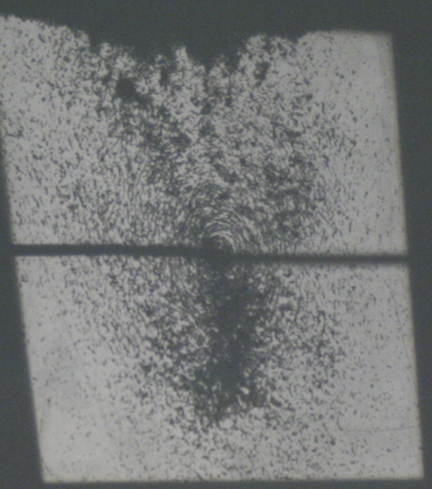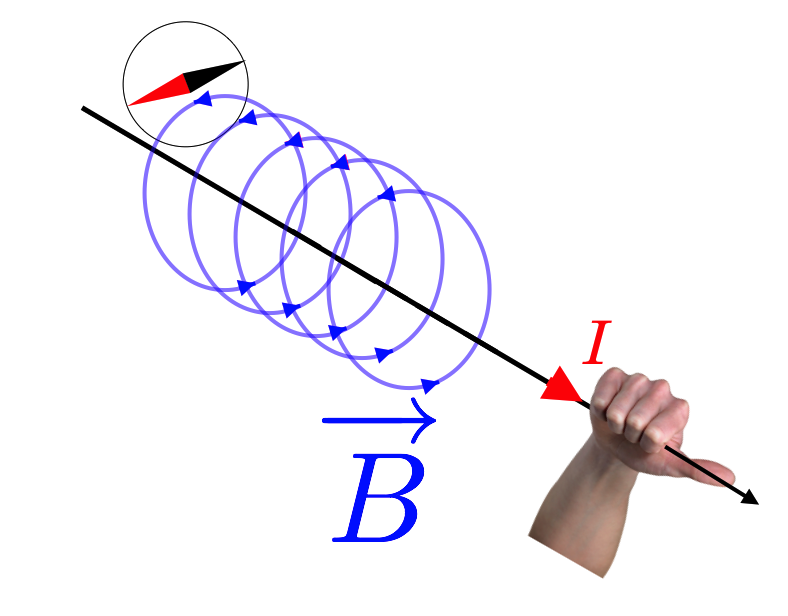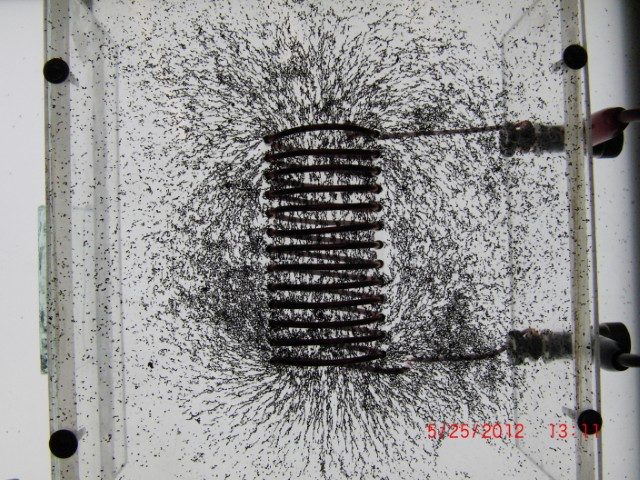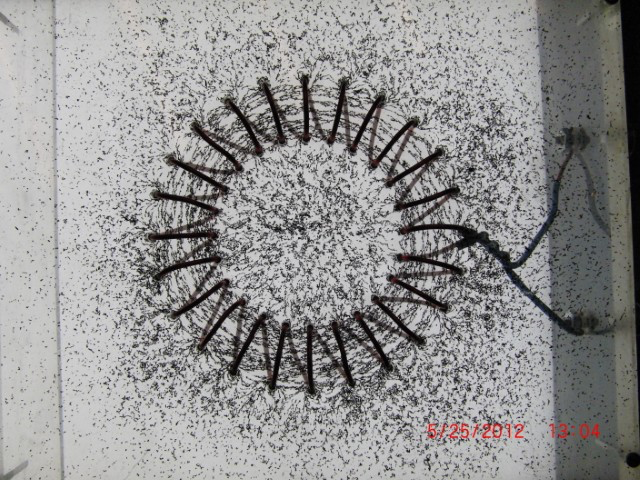13.7. Magnetic Fields#
By this point, it’s no surprise that the field idea could be applied to magnetic configurations, but with a twist. We know of no magnetic charges which would be called “magnetic monopoles.” Not for lack of trying! Many theories of the beginning of the universe demand that they exist. But just as when you might chop a bar magnet in two, and then chop one of the pieces in two, and then again, and again…you will never find a separate North and South pole! Only N-S pole pairs seem to exist, all the way to the atomic level.
The field due to a bar magnet also follows the lines of force and start on the North pole and stop on the South.
Ampere’s guessed that magnetism was due to little circular currents and that’s compatible with the distribution of field lines as can be seen by comparing the iron filings from the bar magnet as sketched by Faraday in the figure at the right with those of the straight wire from his notebook in the previous lesson. Here is a photograph of a more modern attempt:

The concentric circles patiently mapped out by the little iron filings are an indirect map of the concentric circular magnetic field lines, which we’ll refer to as the magnetic field vector \(\vec{B}\). Some reorientation is required. So let’s introduce our first “Right-Hand-Rule.”
This idea of circular fields of influence suggested by (the mathematically illiterate Faraday) was not at all well received by the sophisticated and learned British Newton Fan Club. Forces were supposed to be straight. Ampere’s law (Ampere, the Frenchman) states that a current of magnitude \(I\) will produce a magnetic field in concentric circles around the wire in a direction that you can predict with your right hand: put your thumb in the direction of the current and unless you are built very strangely, your fingers will curl around the direction of the magnetic field, \(\vec{B}\). Here’s how to do it:

The value of the magnetic field diminishes the further one is from the wire, but unlike Coulomb’s Law, the rate of decrease is inversely proportional to the distance: $\(B=k'\frac{I}{2\pi R}\)\( (\)k’$ is a constant that depends on the material outside of the wire.)
Remember Oersted’s discovery? A compass would align itself around a wire when brought near a current. A compass is nothing but a little bar magnet and his discovery was just the statement that the magnet aligns itself with the magnetic field with the north pole following the \(\vec{B}\) field direction. Of course that’s all a compass is doing as a navigational device, since there is a tiny magnetic field due to molten currents in the core of the earth. It’s following the Earth’s \(\vec{B}\) field pointing to the geographical North pole, which is the magnetic South pole.
Now let’s take the wire and bend it into a circle. The field is still concentric around the wire, but look at how its field manifests itself:

Inside of the circle, the field is concentrated where all of the field lines add together (imagine wrapping your fingers around the wire, all around the wire). The field rises out of the plane of the circle, traverses around and returns through the loop from below. It’s exactly the form of the field of a bar magnet. Now Ampere didn’t know this, but his imagination was such that he got it right.
If we make a tube of current circles like a Slinky, the field lines continue to add inside and there result is a useful circuit element called a Solenoid (also useful as a part of your car’s starter circuitry).

The solenoidal magnetic field is nearly uniform inside of the “slinky” wire arrangement and in some sense is the magnetic field analog to the uniform electric field of a parallel plate capacitor.
We can do one more thing with the solenoid…wrap it around a circle like a donut, where the wires encircle the dough. This is called a toroid and is the last field configuration that we’ll need.

In a toroid the magnetic field created is essentially uniform and confined to be within the “donut dough” with no field in the “hole” or around the outside.
Please answer Question 4 for points:
These are the field configurations that we’ll draw on periodically:
Electric field due to a point charge.
Electric field due to oppositely charged parallel plates.
Magnetic field due to a current.
Magnetic field due to a loop.
Magnetic field due to a solenoid.
Magnetic field due to a toroid.
Now let’s build the modern 20th century with Dr Maxwell in the next lesson.